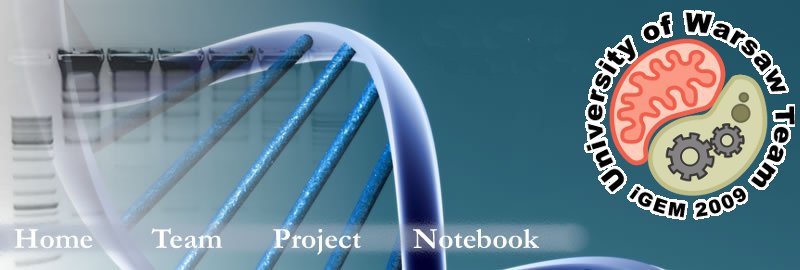Wiki/Team:Warsaw/protocols
From 2009.igem.org
 |
|
|
Lab protocols
introductionHere is the place for the all protocols used by the Warsaw Team during the iGEM 2009. Feel free to add yours. Please be sure to use the
{{Anchor|name of protocol}}
tag before your desired protocol - it simplifies further linking to the protocols in notebook entries (then you will use just [https://2009.igem.org/Team:Warsaw/protocols#protocol_name protocol name] to link to your protocol. You can also put the whole name of protocol (as it's used to define the header of desired protocol) after the # sign (so you can just copy the link from the automatically generated table of contents in the top of page) but in my opinion it's simpler to define shorter/simpler names for linking A great example of describing protocols you can find on the iGEM 2008 Warsaw Team page
Hej !
{{Anchor|name of protocol}}
chyba wcale nie jest potrzebne bo jesli jest wiecej niz 3 ===naglowki=== wiki roi odnosniki w spisie automatycznie
-Ania.
Protocols of the P. GroupChemotransformationAdd desired volume of DNA to the 100-μl-culture in eppendorf tube. Incubate 30 min on ice. Heat shock for 90 s at 42°C. Incubate 10 min on ice. Add 0.9 ml of culture medium and let the bacteria grow at 37°C. Plasmid DNA isolationWe use "Plasmid Mini" plasmid DNA isolation kit from A&A Biotechnology and follow the protocol of producer. DNA isolation from agarose gelWe use "Gel-Out" DNA isolation kit from A&A Biotechnology and follow the protocol of producer. DNA purification after enzymatic reactionWe use "Clean-Up" DNA purification kit from A&A Biotechnology and follow the protocol of producer. Genomic DNA isolationWe use "Genomic-Mini" universal genomic DNA isolation kit from A&A Biotechnology and follow the protocol of producer. DNA digestWe use restriction enzymes and buffers provided by Fermentas. Overall volume of digest mix is either 20 μl, either 50 μl in case of digesting for ligation. We usually use 1 μl of restriction enzyme and the buffer in 10x dilution (as they initially are 10x concentrated). The rest of mix is plasmid DNA. Protocols of the M. GroupAlkaline lysisPerform on ice, centrifuge in 4°C . Solution: 1,2,3 and 70% ethanol solution are prepared in advance. Solution 1 and 3 are stored in the refrigerator. Solution 2 should be stored at room temperature, no longer than 4-6 days. Solution should be mixed by inverting the tubes before use. The volumes of the solutions in this protocol are for the alkaline lysis of the pellet from 3ul overnight culture of E.Coli. For the pellet from 5 μl use greater volumes. Solution 1 - Solution 2 - NaOH 0.2M, SDS 1% Solution 3 - 70% ethanol solution
2. Discharge the supernatant. 3. Add 100 μl of Solution 1, uniformly suspend cells by pipetting. 4. Wait 5 min. At this stage pH is changed and cell membrane is destabilised 5. Add 150 μl of Solution 2, mix by inverting the eppendorf 5 times. 6. Wait 3 minutes. At this stage cells are lysed by SDS and NaOH denatures the DNA. Solution should become more transparent. 7. Add 150 μl of Solution 3, mix by inverting the eppendorf 5 times. 8. Wait 5 min. Plasmid DNA renaturates. Contaminant should be visible as a white layer. 9. Centrifuge at the maximum speed for 10 min in 4°C. The plasmid DNA is in the supernatant. Contaminants are in the pellet 10. Pippete the supernatant into the new eppendorfs.Be careful not to pipette the pellet. 11. Add 0,8 ml of the pure isopropanol into each eppendorf mix gently. It precipitates the plasmid. 12. Incubate at -20 or -80 for 10 min or more. Improves efficiency. 13. Centrifuge at the maximum speed for 10 min in 4°C. 14. Discharge the supernatant. Plasmid is in the pellet. 15. Add 1 ml of 70% ethanol into each eppendorf to rinse the pellet. 16. Centrifuge at the maximum speed for 10 min in 4°C. 17. Discharge the supernatant gently and air-dry the eppendorfs for 10-30 minutes to allow the ethanol to evaporate. 18. Suspend the dry pellet in 40 μl of Tris-EDTA buffer with RNAses. Chemotransformation1. Take the eppendorf with chemically competent cells out of -80°C. 2. Defrost on ice for 10 minutes. 2. Add the DNA (10-20 μl if cells are transformed with ligation mix / 4 μl of the DNA if cells are transformed with the DNA from 2009 distribution kit plates). 3. Gently mix by pipetting the cells. 4. Chill on ice for 30 minutes. 5. Heat shock at 42°C for 60 seconds. 6. Chill on ice for 10 minutes. 7. Add 1mil of LB broth. 8. Incubate at 37°C for 1 hour. 9. Plate 100μl of the culture on the agar plate with appropriate antibiotic. 10. Centrifuge at 6 000 rpm for 2 min. 11. Discharge most of the supernatant. Leave around 100 μl total volume. 12. Suspend the pellet in the reminded supernatant. 13. Plate 100μl of the concentrated culture on the agar plate with appropriate antibiotic. 14. After transformation cells need to be grown under selection conditions. Selective Media preparation. Agar plates with appropriate antibiotic should be fresh to maintain the proper concentration of the antibiotic.0,1g/ml Ampicilin and Kanamycin solutions are stored in the freezer.
|
 "
"